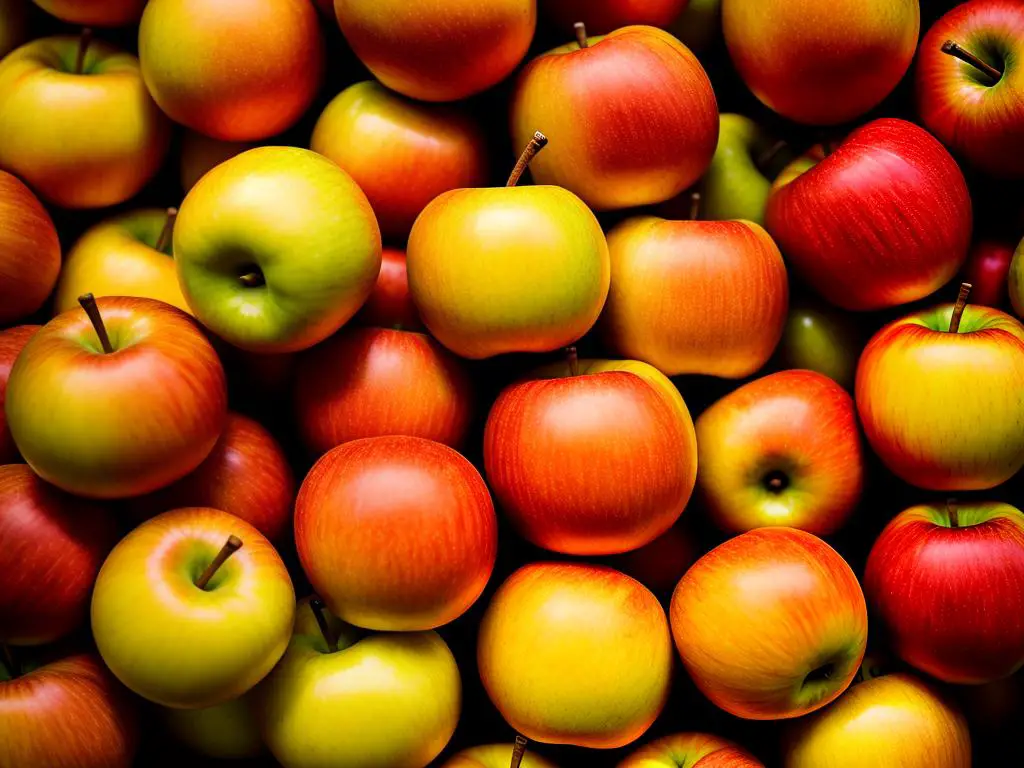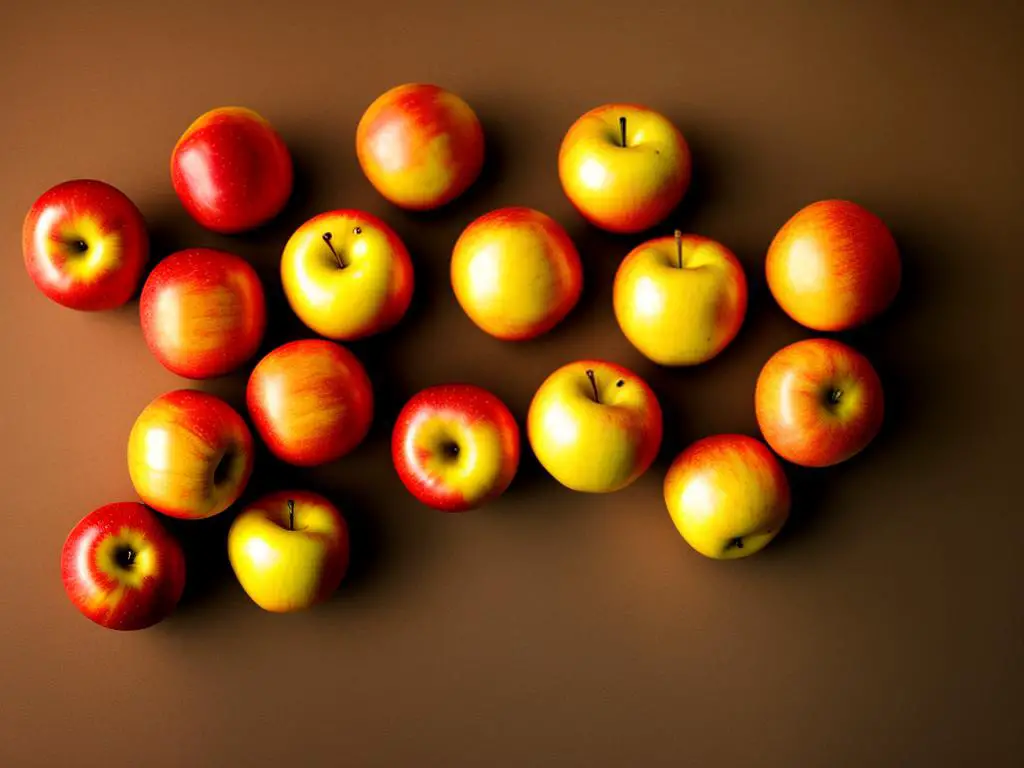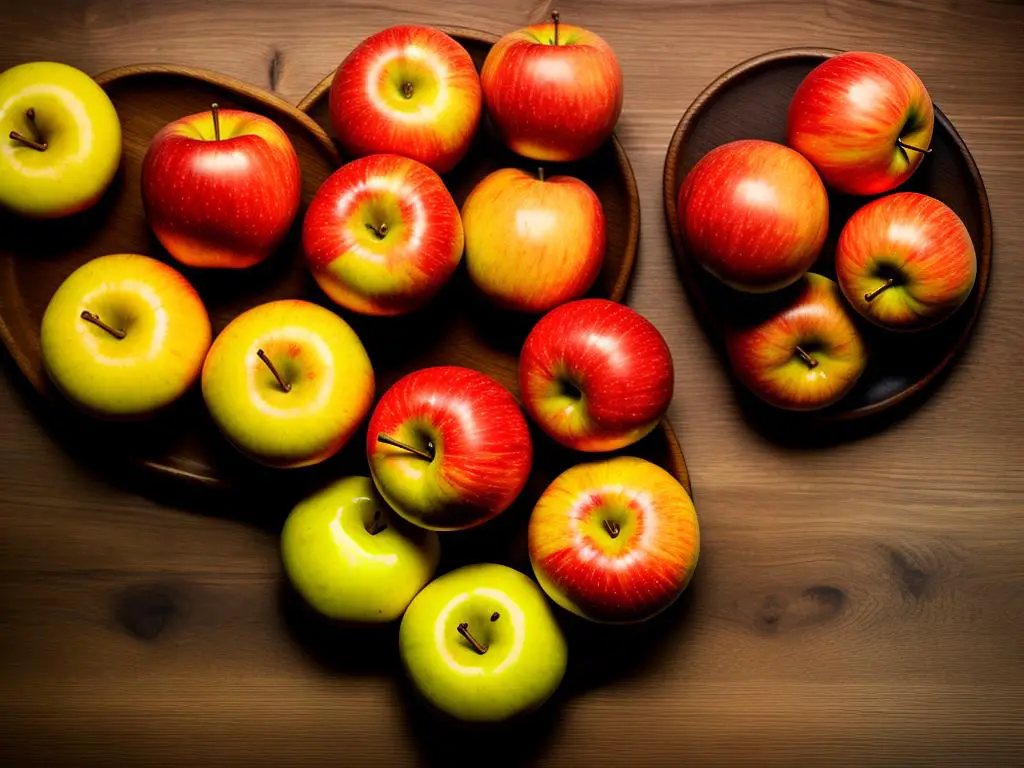Golden Russet Apples, rich in history, splendorous in appearance, and unrivaled in taste, are as golden and regal as their name suggests. Nestled in the abundance of nature, these apples take us on a journey through time, tracing their birth, propagation, and evolution over the centuries. Strap in as you explore the world of this remarkable fruit, an exemplification of nature’s best.
Also, brace yourselves as we unravel the secrets that lie beneath its russet skin – the apple’s distinguishing attributes, its distinct visual characteristics and splendid taste. More importantly, come to appreciate their flexible adaptability to diverse climates and their fascinating growth patterns.
History of Golden Russet Apples
Origins of Golden Russet Apples: A Taste of American Heritage
Golden Russet apples, sometimes known as “American Golden Russet” or “English Golden Russet”, are believed to have originated in America during the early 18th century. It is generally thought to be an all-American heirloom apple variety, as it was first noted in an orchard at the south of the Hudson River in New York in 1845. However, it is also conceivable that some strains may have been brought over from Europe by early settlers.
Propagation and Distribution
The propagation of Golden Russet apples occurred naturally and was facilitated by the settlers as they traveled westward. These pioneers took seeds with them as they moved away from the eastern coast, planting apple trees as they established new homes. As a result, the Golden Russet became a popular apple choice in many parts of the United States, particularly in the Northeast and along the Great Lakes.
Golden Russet trees are known for their resilience and adaptability. They can thrive in different weather conditions and can adapt to various types of soil, making them a suitable choice for diverse agricultural regions. Golden Russets have also made their way north to Canada, where they enjoy similar popularity.
Historical Significance of Golden Russet Apples
Valued throughout history for their unique flavor profile and versatility, Golden Russet apples are known for their complex taste that perfectly combines sweetness, tartness, and a hint of spice. The “russeting” these apples are named for refers to their rough, leather-like skin, which can have a variety of colors ranging from coppery-orange to a dull gray-green.
During the 18th and 19th centuries, Golden Russets were a staple in cider mills due to their high juice yield. The cider produced from these apples was notably sweet and potent, earning them a favored status among cider connoisseurs.
These apples were also sought after for their impressive storage capability. They could remain fresh in root cellars throughout the winter while retaining their distinctive flavor and quality. This characteristic made them precious in pre-refrigeration eras, offering a healthy food supply during the austerity of winter months.
Golden Russets left their mark in the art and literature of their time, underscoring their cultural and historical significance in America. Even in the face of newer apple varieties, Golden Russets maintain their prestigious status among apple enthusiasts, each bite evocative of a slice of rich American history.

Cultivation and Characteristics of Golden Russet Apples
A Closer Look at Golden Russet Apples: Varieties Steeped in History and Flavor
Golden Russet apples combine a fine-grained texture with a distinctive, sweet flavor, earning them high praise. These apples can trace their origins to a seedling discovered in upstate New York in the 19th century. The rich and rustic history of this apple variety is steeped in allusions to pioneers and the early American settlers.
Characteristics of Golden Russet Apples
Golden Russet apples are notable for their exceptional sweetness, offering a rich, honeyed flavor with a hit of spice. Their remarkable sweetness is matched with a punch of acidity for a well-rounded, robust taste.
They differ in appearance from many supermarket apples. Their namesake russet skin is thick, rough, and golden brown in nature. The flesh of the apple, on the other hand, is firm, crisp, and of a yellowish hue. The texture is fine-grained and occasionally seems almost buttery, which adds to the apple’s unique appeal. Its size can range from medium to large, and they have a somewhat irregularly-shaped, slightly flattened appearance.
Growing Conditions and Cultivation Techniques
Golden Russet apples are typically grown in cooler northern climates, preferring regions with cold winters and mild summer temperatures. The trees are of medium vigor, growing up to a height of 10 to 25 feet. As a late-season apple, the Golden Russet is harvested from late October to early November, which makes them one of the last varieties to be picked.
They are a hardy apple, capable of withstanding many diseases that are known to harm other apple varieties. They are resistant to apple scab and moderately resistant to fire blight and cedar apple rust. These disease resistant traits make Golden Russet apples a desirable choice for organic growers.
The trees require optimal sunlight (around six hours a day) and well-drained soil for peak productivity. Golden Russets, like many apple trees, benefit from regular pruning to promote air circulation and strong branch growth.
This apple variety does have a tendency towards biennial bearing, producing a large crop one year followed by a smaller yield the next year. Implementing practices such as annual pruning and proper thinning of the fruits can help promote a more consistent annual yield.
Thriving Regions of the Golden Russet Apple
The Golden Russet Apple flourishes in a diversity of climates, though they are predominant in the key apple-growing states of the United States. These regions include New York, which is believed to be the place of origin of this apple, Michigan and various areas within New England.
Golden Russet apples have versatile culinary uses. They are delightful when eaten fresh, but are equally good when baked into pies. What sets it apart though, is that it is the apple of choice for cider-makers due to its bright, full-bodied flavor.
Although its russeted skin has led to a decline in commercial production, as it is often deemed less attractive compared to the glossy skins of modern apples, the Golden Russet apple maintains its popularity among apple enthusiasts and cider producers. They value its unique, complex flavor and rustic appeal.

Uses and Benefits of Golden Russet Apples
The Unique Uses and Benefits of Golden Russet Apples
The Golden Russet Apples, an heirloom variety mostly found in the northeastern United States, stand out due to their unique sweet-spicy flavor and their distinctive mottled golden skin. Despite their northeastern origins, these apples can also be found in various parts of the globe.
The robust, sweet juice that these apples produce make them particularly suitable for making traditional cider. The strong flavor they lend to the cider makes it deeply satisfying and unmatched in richness.
Golden Russet Apples prove to be phenomenal in other culinary uses too. Due to their high sugar content and firmness, they retain their texture and flavor even when baked, making them a popular apple variety for making pies and tarts. Their sweet yet tangy flavor coupled with dense flesh makes them great for raw consumption, providing a unique snacking experience. They also add a lovely, fruity sweetness when used in salads, complementing a wide range of other ingredients.
Health Benefits and Nutritional Facts
Golden Russet Apples carry numerous health benefits. They are low in calories and high in dietary fiber, aiding in improved digestion and satiety. Additionally, these apples are rich in Vitamin C, a potent antioxidant beneficial for your immune health and skin. They also contain other essential nutrients like potassium and Vitamin K.
Compared to other apple varieties, the Golden Russet Apples have a higher sugar content, making them a potential natural substitute for sweetening in recipes. This, however, doesn’t mean they are unhealthy. In fact, these sugars are naturally occurring and come along with dietary fibers and essential nutrients, making it a healthier option over artificial sweeteners.
It’s important to remember that most of the apple’s fiber and nutrients reside in its skin. So for the maximum nutritional punch, consider eating these apples with their skin on.
In summary, Golden Russet Apples prove their worth not only in versatility and flavor profile but also in their nutritional offerings. Perfect for cider making, baking, or just plain snacking, enjoy the wholesome benefits of this uncommon apple variety.

Who knew that beneath the golden russet skin lies versatility beyond compare? From extolling the apple’s culinary versatility in dishes, pastries, and ciders to emphasizing their health benefits, one thing is undeniably clear: Golden Russet Apples embody richness, in taste, nutrition, and use. Indeed, these apples offer more than just a tantalizing crunch. They provide an engaging, healthful eating experience that leaves a lasting imprint on your palate.
Few fruits can dispute the Golden Russet’s triumph as a testament to nature’s abundance. The journey of discovering this apple variety enriches our understanding of nature’s bounty. Understanding the story, cultivation, and benefits of Golden Russet Apples nurtures our appreciation for these golden nuggets of delight and their significance in our daily lives.